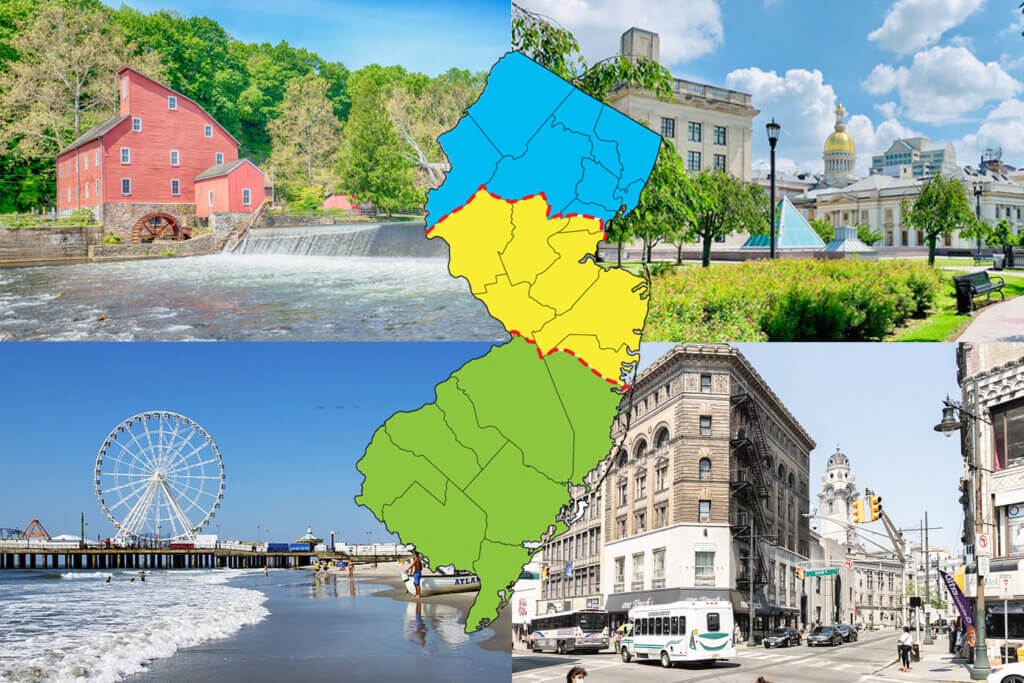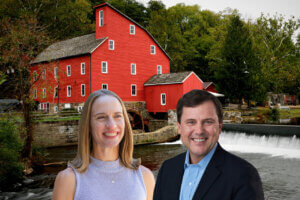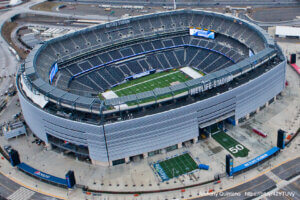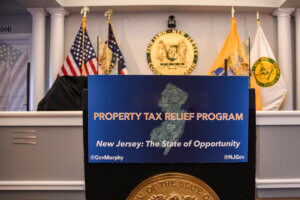West Long Branch, NJ – New Jersey residents are divided on whether their part of the state gets its fair share of state resources, but there are wide regional variations in this opinion. The Monmouth (“Mon-muth”) University Poll finds that South Jersey residents feel most overlooked while Central Jerseyans are happiest with their share of state resources. The poll also attempts to settle a couple of burning questions in the Garden State. First, where exactly is Central Jersey? Second, what is New Jersey’s favorite convenience store?
When asked about the distribution of government spending and programs, 43% of New Jerseyans feel their region of the state gets its fair share of state resources while 47% feel it does not. A majority of Central Jersey residents (54%) say their region gets its fair share; 36% say it does not. At the other end of the spectrum, only 26% of South Jersey residents say their region gets its fair share, while nearly two-thirds (64%) say it does not. North Jersey residents are evenly divided – 45% say their region gets its fair share and 45% say it does not.
Focusing on New Jerseyans who feel their region does not get its fair share of state resources, the vast majority of this group in the southern (89%) and central (79%) parts of the state say that North Jersey is the region that gets more than its fair share. Among northern residents who feel they don’t get their fair share from the state, 35% say South Jersey gets more and 31% say Central Jersey gets more. Interestingly, though, 20% of North Jersey residents who say their region does not get its “fair share” feel it actually gets more than its fair share when they answer the poll’s follow-up question.
“It’s the same old Garden State story. South Jersey feels left out and North Jersey doesn’t seem to mind,” said Patrick Murray, director of the independent Monmouth University Polling Institute.
Determining regional definitions in New Jersey is a tricky business. When asked to name their home region, 41% of state residents say they live in North Jersey, 34% say Central Jersey, and 23% say South Jersey. The Monmouth University Poll uses a county-based definition of those three regions for its own demographic analysis of state opinion. Nearly 9 in 10 state residents are in agreement with how Monmouth describes their home region. There are a few pockets where slight disparities make sense. For example, some residents of the Somerset County towns of Bernardsville and Basking Ridge – which abut Morris County – tend to see themselves more in the northern part of the state. There are other differences, though, where residents’ own regional description is harder to reconcile with actual geography – such as in the Morris County towns of Roxbury and Rockaway as well as in a swath of Essex County from the Oranges to Maplewood – where some residents see themselves as living in Central Jersey.
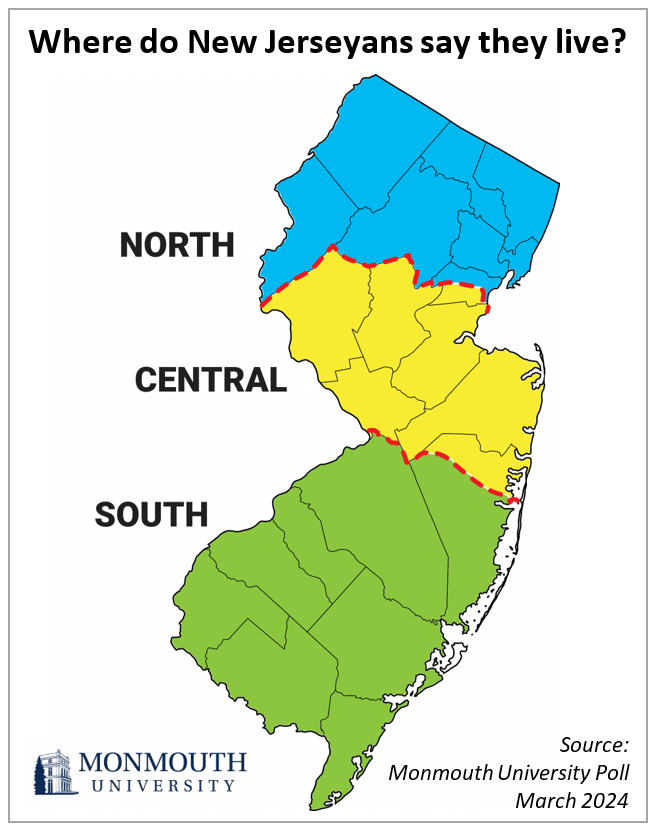
There are two places, however, where we find a sizable difference of opinion between the Monmouth poll’s regional definitions and how residents themselves see it. These occur in Union and Ocean counties. Monmouth defines all of Union County as being in North Jersey, but about half the county’s residents see themselves as living in Central Jersey. Those residents tend to be located in a wedge of the county roughly defined as being west of State Route 27 and south of State Route 28. This includes the towns, or parts, of Clark, Cranford, Garwood, Plainfield, Rahway, Roselle, Roselle Park, Scotch Plains, Union Township, Westfield, and Winfield. Similarly, about half of those living in Ocean County – which the Monmouth poll defines as South Jersey – see themselves as Central Jerseyans. These residents generally live in the parts of Jackson and Toms River that lie north of County Route 571, and also include Brick and Lakewood townships, as well as the coastal towns of Bayhead, Lavallette, Mantoloking, Point Pleasant (Boro and Beach), Seaside Heights and Seaside Park.
“Now that there is official recognition Central Jersey exists, it seems everyone wants to live there. Or at least say they live there,” said Murray.
The Monmouth Poll also asked state residents which convenience store is their favorite. Half (50%) choose Wawa. The chain, which marks its 60th anniversary today, is far ahead of 7-Eleven (15%), QuickChek (14%), and other stores (10%) in the hearts and minds of New Jerseyans. Wawa is easily the favorite convenience stop in the southern part of the state where it has had a foothold since its earliest days, with 8 in 10 South Jersey residents (79%) choosing it as their favorite. It is also the top convenience store pick of a majority of Central Jersey residents (61%). In North Jersey, where it is a relative newcomer, Wawa (31%) just edges out 7-Eleven (24%) as this region’s favorite convenience store with QuickChek (19%) showing a strong third place. The close results in North Jersey are actually driven by a large split in urban and suburban opinion there. In the northern region’s cities and urban centers, 7-Eleven actually emerges as the top spot for convenience purchases (38%), followed by Wawa (25%) and QuickChek (19%). In suburban North Jersey, though, Wawa (34%) has the edge over QuickChek (20%) and 7-Eleven (15%). [According to published reports, Wawa and 7-Eleven have at least twice as many locations in New Jersey as QuickChek.]
“It wasn’t that long ago when you wouldn’t even have heard of Wawa north of the Raritan River. It appears to be taking over the entire state, although 7-Eleven is holding its own in New Jersey’s cities,” said Murray. [Disclosure: the Monmouth poll director worked his way through college at a Wawa store in Pennsylvania.]
The Monmouth University Poll was conducted by telephone from February 29 to March 4, 2024 with 801 New Jersey adults. The question results in this release have a margin of error of +/- 4.2 percentage points for the full sample. The poll was conducted by the Monmouth University Polling Institute in West Long Branch, NJ. [New Jersey map graphic courtesy Mike Richison, Associate Professor of Art & Design, Monmouth University.]
QUESTIONS AND RESULTS
(* Some columns may not add to 100% due to rounding.)
[Q1-39 previously released.]
40.Do you call the part of the state where you live North, Central, or South Jersey?
| Trend: | March 2024 | Jan. 2008 |
|---|---|---|
| North Jersey | 41% | 40% |
| Central Jersey | 34% | 35% |
| South Jersey | 23% | 23% |
| (VOL) Don’t know | 2% | 2% |
| (n) | (801) | (804) |
41.Thinking about government spending and programs, do you think your region of New Jersey gets its fair share of state resources, or not?
| Response: | March 2024 |
|---|---|
| Fair share | 43% |
| Not fair share | 47% |
| (VOL) Don’t know | 10% |
| (n) | (801) |
[Question 41A was asked of those who say their region does not get its fair share in Q41; n=358, moe=+/-6.3%.]
41A.Which region do you think gets more than its fair share of state resources?
| Response: | March 2024 |
|---|---|
| North Jersey | 56% |
| Central Jersey | 17% |
| South Jersey | 19% |
| (VOL) Don’t know | 7% |
| (n) | (358) |
42.Which of the following is your favorite convenience store: 7-Eleven, QuickChek, Wawa, or something else? [STORE NAMES WERE ROTATED]
| Response: | March 2024 |
|---|---|
| 7-Eleven | 15% |
| QuickChek | 14% |
| Wawa | 50% |
| Something else | 10% |
| (VOL) None | 8% |
| (VOL) Don’t know | 2% |
| (n) | (801) |
METHODOLOGY
The Monmouth University Poll was sponsored and conducted by the Monmouth University Polling Institute from February 29 to March 4, 2024 with a probability-based random sample of 801 New Jersey adults age 18 and older. Interviews were conducted in English, and included 259 live landline telephone interviews, 375 live cell phone interviews, and 167 online surveys via a cell phone text invitation. Telephone numbers were selected through a mix of random digit dialing and list-based sampling. Landline respondents were selected with a modified Troldahl-Carter youngest adult household screen. Interviewing services were provided by Braun Research, with sample obtained from Dynata (RDD, n= 657) and Aristotle (list, n= 144). Monmouth is responsible for all aspects of the survey design, data weighting and analysis. The full sample is weighted for region, age, education, gender and race based on US Census information (ACS 2021 one-year survey. For results based on this sample, one can say with 95% confidence that the error attributable to sampling has a maximum margin of plus or minus 4.2 percentage points adjusted for sample design effects (1.49). Sampling error can be larger for sub-groups (see table below). In addition to sampling error, one should bear in mind that question wording and practical difficulties in conducting surveys can introduce error or bias into the findings of opinion polls.
NJ Regions (by county)
North – Bergen, Essex, Hudson, Morris, Passaic, Sussex, Union, Warren
Central – Hunterdon, Mercer, Middlesex, Monmouth, Somerset
South – Atlantic, Burlington, Camden, Cape May, Cumberland, Gloucester, Ocean, Salem
Demographics (weighted)
Party (self-reported): 26% Republican, 37% Independent, 37% Democrat
Sex: 49% male, 51% female, 1% other
Age: 28% 18-34, 33% 35-54, 39% 55+
Race: 55% White, 13% Black, 19% Hispanic, 13% Asian/other
Education: 34% high school or less, 25% some college, 23% 4 year degree, 18% graduate degree
Click on pdf file link below for full methodology and crosstabs by key demographic groups.

